Rambutan
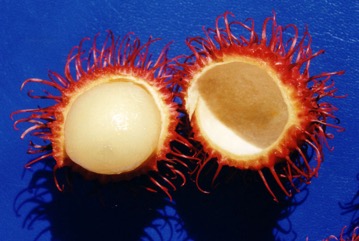
A tropical plant. It suits the humid tropical lowlands. It is native to Malaysia. It requires a moist hot climate mostly within 12° of the equator. They extend from sea level up to altitudes of about 500 m in equatorial zones and will grow about 17° from the equator. They do best where the temperature is constant around 28°C or range from 22-30°C and rainfall of 2000 to 5000 mm per year. Low humidity can cause scorching of leaves. Excessive rainfall before flower formation reduces flowering. A dry period of about one month assists flower initiation and areas with two seasonal dry periods can get double crops. A well drained soil is needed. It is best with a pH between 4.5-6.5. In XTBG Yunnan. It suits hardiness zones 11-12.
Also known as:
Amaw, Arem litchi, Chom chom, Gente, Gerat, Haicha, Hairy litchi, Hong mao dan, Kakapas, Kyetmauk, Legos, Nefelio, Nerat, Ngoh, Ngork, Phruan, Poilus, Ramboetan, Ramboostan, Rambosteen, Rambotan, Ramboutanier, Rambutan hutan, Rambutan usan, Rambutao, Ramtum, Ranbuutan, Saaw maaw, Saw maw, Ser mon, Tangoi, Tangui, Usan, Usau, Vai thieu
Synonyms
- Euphoria glabra Blume
- Euphoria nephelium DC
- Euphoria nephelium Poir.
- Euphoria ramb-outan Labill.
- Litchi ramboutan Labill.
- Nephelium chryseum Blume
- Nephelium glabrum Cambess.
- Nephelium glabrum var. sufferrugineum (Radlk.) Ridl.
- Nephelium glabrum Norona
- Nephelium glabrum Reinw. ex Blume
- Nephelium lappaceum var. glabrum Blume
- Nephelium maculatum Radlk.
- Nephelium mutabile var. pallens Hiern
- Nephelium obovatum Ridl.
- Nephelium pallens (Hiern) Radlk.
- Nephelium rambutan Schnizl.
- Nephelium sufferrugineum Radlk.
- Nephelium xanthoides Radlk.
Edible Portion
- Fruit, Seeds
Where does Rambutan grow?
Found in: Africa, Andamans, Asia, Australia, Bougainville, Brazil, Brunei, Cambodia, Cameroon, Central Africa, Central America, China, Congo DR, Cook Islands, Costa Rica, Cuba, East Africa, East Timor, Fiji, FSM, Ghana, Guam, Guiana, Hawaii, Honduras, India, Indochina, Indonesia, Laos, Liberia, Madagascar, Malaysia, Mexico, Myanmar, Northeastern India, Pacific, Palau, Panama, Papua New Guinea, PNG, Philippines, Pohnpei, SE Asia, Seychelles, Singapore, Solomon Islands, South America, Sri Lanka, Suriname, Tanzania, Thailand, Timor-Leste, United States, Vietnam, West Africa, West Papua
Notes: Demo
Status: It is an important fruit tree in SE Asia. Trees have been planted in several coastal areas of Papua New Guinea and produce well.
Growing Rambutan
Cultivation: Trees can be grown from fresh seeds. The seeds are short lived so need to be planted fresh, after washing. Germination takes place in 7-10 days. Seedlings are not easy to transplant. Roots are very sensitive to drying out. Selected trees can be propagated by budding, grafting or air-layering. Seedling trees vary considerably in quality due to cross pollination. Trees are planted 10 m apart. Planting densities of 80-120 trees per hectare occur. About 1% male flowers are sufficient if enough pollinating insects are present. Some kinds need to have varieties mixed in the garden to get good fruit set. Twice yearly applications of organic manure are often used.
Edible Uses: The fruit are eaten fresh. More sour fruit are eaten stewed. The seeds are sometimes roasted and eaten. The seed can be used for oil. Fruit are available in cans and frozen.
Production: Seedling trees can start to bear after 6 years and vegetative trees after 4 years. Fruiting is seasonal. Flowering occurs during the dry season. The main fruit season is November to March. Fruit mature about 110 days after flowering. Where trees with only female flowers occur, male pollinator trees are needed. Fruit can weigh 20 to 40 g each. Fruit need to be harvested when ripe. A well maintained tree can produce 150 kg of fruit.
Nutrition Info
per 100g edible portion| Edible Part | Energy (kcal) | Protein (g) | Iron (mg) | Vitamin A (ug) | Vitamin c (mg) | Zinc (mg) | % Water |
|---|---|---|---|---|---|---|---|
| Fruit - raw | 65 | 1 | 1.9 | 0 | 53 | 0.1 | 82 |
Rambutan Photos

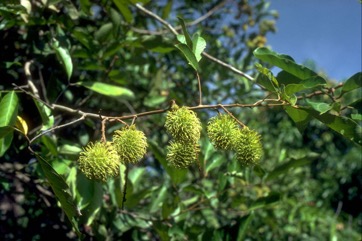
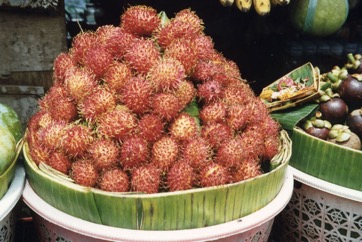
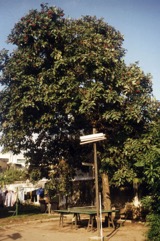
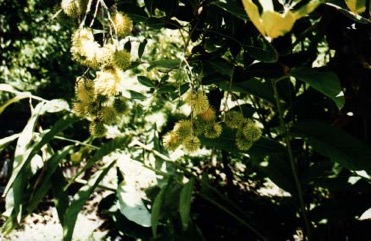
References
AAK, 1980, Bertanam Pohon Buah-buahan. Penerbitan Yayasan Kanisius, Jogyakarta. p 65
Abbiw, D.K., 1990, Useful Plants of Ghana. West African uses of wild and cultivated plants. Intermediate Technology Publications and the Royal Botanic Gardens, Kew. p 42
Adema, Leenhouts, P. W., 1994, Sapindaceae, Flora Malesiana Ser 1 Vol 11 (3) p 672
Alexander, D.M., Scholefield, P.B., Frodsham, A., 1982, Some tree fruits for tropical Australia. CSIRO, Australia. p 41
Ambasta, S.P. (Ed.), 2000, The Useful Plants of India. CSIR India. p 396
Argent, G et al, nd, Manual of the Larger and More important non Dipterocarp Trees of Central Kalimantan Indonesia. Volume 2 Forest Research Institute, Samarinda, Indonesia. p 567
Arora, R. K., 2014, Diversity in Underutilized Plant Species - An Asia-Pacific Perspective. Bioversity International. p 79
Ashton, M. S., et al 1997, A Field Guide to the Common Trees and Shrubs of Sri Lanka. WHT Publications Ltd. pdf p 358
Barwick, M., 2004, Tropical and Subtropical Trees. A Worldwide Encyclopedic Guide. Thames and Hudson p 295
Bodkin, F., 1991, Encyclopedia Botanica. Cornstalk publishing, p 722
Brown, W.H., 1920, Wild Food Plants of the Philippines. Bureau of Forestry Bulletin No. 21 Manila. p 106
Burkill, I.H., 1966, A Dictionary of the Economic Products of the Malay Peninsula. Ministry of Agriculture and Cooperatives, Kuala Lumpur, Malaysia. Vol 2 (I-Z) p 1571
Call, C. A., et al, 2004, Participatory Rural Appraisal in the Upland Ecosystem of Mt Malindang, Misamis Occidental, Philippines. Biodiversity Research Programme for Development in Mindanao. p 60
Chai, P. P. K. (Ed), et al, 2000, A checklist of Flora, Fauna, Food and Medicinal Plants. Lanjak Entimau Wildlife Sanctuary, Sarawak. Forestry Malaysia & ITTO. p 170
Cheifetz, A., (ed), 1999, 500 popular vegetables, herbs, fruits and nuts for Australian Gardeners. Random House p 210
Chin, H.F., & Yong, H.S., 1996, Malaysian Fruits in Colour. Tropical press, Kuala Lumpur p6
Coronel, R.E., 1982, Fruit Collections in the Philippines. IBPGR Newsletter p 7
Cull, B.W., 1995, Fruit Growing in Warm Climates. Reed. p 181
Darley, J.J., 1993, Know and Enjoy Tropical Fruit. P & S Publishers. p 61
Dodo, 2015, Keanekaragaman dan konservasi Tumbuhan Buah Langka Indonesia. Pusat Konservasi Tumbuhan Kebun Raya – LIPI. Warta Kebun Raya 13(2)
Engel, D.H., & Phummai, S., 2000, A Field Guide to Tropical Plants of Asia. Timber Press. p 108
Etherington, K., & Imwold, D., (Eds), 2001, Botanica's Trees & Shrubs. The illustrated A-Z of over 8500 trees and shrubs. Random House, Australia. p 491
Facciola, S., 1998, Cornucopia 2: a Source Book of Edible Plants. Kampong Publications, p 225
Flowerdew, B., 2000, Complete Fruit Book. Kyle Cathie Ltd., London. p 160
French, B.R., 1986, Food Plants of Papua New Guinea, A Compendium. Asia Pacific Science Foundation p 277
Garner, R.J., and Chaudhri, S.A., (Ed.) 1976, The Propagation of Tropical fruit Trees. FAO/CAB. p 518
Hearne, D.A., & Rance, S.J., 1975, Trees for Darwin and Northern Australia. AGPS, Canberra p 90, Pl 25
Hedrick, U.P., 1919, (Ed.), Sturtevant's edible plants of the world. p 436
Henty, E.E., 1980, Harmful Plants in Papua New Guinea. Botany Bulletin No 12. Division Botany, Lae, Papua New Guinea. p 122, 123
Hibbert, M., 2002, The Aussie Plant Finder 2002, Florilegium. p 210
Hu, Shiu-ying, 2005, Food Plants of China. The Chinese University Press. p 525
INFOODS:FAO/INFOODS Databases
Jardin, C., 1970, List of Foods Used In Africa, FAO Nutrition Information Document Series No 2.p 149
John, L., & Stevenson, V., 1979, The Complete Book of Fruit. Angus & Robertson p 291
Kiple, K.F. & Ornelas, K.C., (eds), 2000, The Cambridge World History of Food. CUP p 1842
Latham, P., 2004, Useful Plants of Bas-Congo province. Salvation Army & DFID p 201
Lazarides, M. & Hince, B., 1993, Handbook of Economic Plants of Australia, CSIRO. p 170
Lembaga Biologi Nasional, 1977, Buah-Buahan, Balai Pustaka, Jakarta. p 108
Lorenzi, H., Bacher, L., Lacerda, M. & Sartori, S., 2006, Brazilian Fruits & Cultivated Exotics. Sao Paulo, Instituto Plantarum de Estuados da Flora Ltda. p 614
Lungphi, P., Wangpan, T. & Tangjang, S., 2018, Wild edible plants and their additional uses by the Tangsa community living in the Changlang district of Arunachal Pradesh, India. Pleione 12(2): 151 - 164. 2018.
Macmillan, H.F. (Revised Barlow, H.S., et al) 1991, Tropical Planting and Gardening. Sixth edition. Malayan Nature Society. Kuala Lumpur. p 288
Maisuthisakul, P., 2012, Phenolic Constituents and Antioxidant Properties of some Thai Plants. Chp. 9 in Book Phytochemicals - A Global Perspective of Their Role in Nutrition and Health
Mant. pl. 1:125. 1767
Martin, F. W., et al, 1987, Perennial Edible Fruits of the Tropics. USDA Handbook 642 p 57
Martin, M.A., 1971, Introduction L'Ethnobotanique du Cambodge. Centre National de la Recherche Scientifique. Paris.
McMakin, P.D., 2000, Flowering Plants of Thailand. A Field Guide. White Lotus. p 109
Miguel, E., et al, 1989, A checklist of the cultivated plants of Cuba. Kulturpflanze 37. 1989, 211-357
Monsalud, M.R., Tongacan, A.L., Lopez, F.R., & Lagrimas, M.Q., 1966, Edible Wild Plants in Philippine Forests. Philippine Journal of Science. p 543
Morton, J. F., 1987, Fruits of Warm Climates. Wipf & Stock Publishers p 262
Mozhui, R., et al, 2011, Wild edible fruits used by the tribals of Dimapur district of Nagaland, India. Pleione 5(1): 56 - 64.
Nathan, A., & Wong Y Chee, 1987, A Guide to Fruits and Seeds, Singapore Science Centre. p 32
Norrington, L., & Campbell, C., 2001, Tropical Food Gardens. Bloomings Books. p 115
Owen, S., 1993, Indonesian Food and Cookery, INDIRA reprints. p 80
Pawera, L., et al, 2020, Wild Food Plants and Trends in Their Use: From Knowledge and Perceptions to Drivers of Change in West Sumatra, Indonesia, Foods. 2020, 9, 1240
Peekel, P.G., 1984, (Translation E.E.Henty), Flora of the Bismarck Archipelago for Naturalists, Division of Botany, Lae, PNG. p 341, 340
Phon, P., 2000, Plants used in Cambodia. © Pauline Dy Phon, Phnom Penh, Cambodia. p 467
Priyadi, H., et al, Five hundred plant species in Gunung Halimun Salak National Park West Java. A checklist including Sundanese names, distribution and use. CIFOR, FFPRI, SLU p 147
PROSEA (Plant Resources of South East Asia) handbook, Volume 2, 1991, Edible fruits and nut. p 235
Purseglove, J.W., 1968, Tropical Crops Dicotyledons, Longmans. p 644
Rajapaksha, U., 1998, Traditional Food Plants in Sri Lanka. HARTI, Sri Lanka. p 449
Segura, S., et al, 2018, The edible fruit species in Mexico. Genet Resour Crop Evol (2018) 65:1767–1793
Sharma, B.B., 2005, Growing fruits and vegetables. Publications Division. Ministry of Information and broadcasting. India. p 132
Slik, F., www.asianplant.net
Smith, P.M., 1979, Rambutan, in Simmonds, N.W., (ed), Crop Plant Evolution. Longmans. London. p 320
Soepadmo, E. and Wong, K. M. and Saw, L. G., 1996, Tree Flora of Sabah and Sarawak. Forestry Malaysia. Volume Two. p 342
Solomon, C., 2001, Encyclopedia of Asian Food. New Holland. p 304
Solomon Islands Ministry of Agriculture, 1996, Solomon Islands: Country report to the FAO International Technical Report of Plant Genetic Resources. Leipzig. p 23
Staples, G.W. and Herbst, D.R., 2005, A tropical Garden Flora. Bishop Museum Press, Honolulu, Hawaii. p 517
Sukarya, D. G., (Ed.) 2013, 3,500 Plant Species of the Botanic Gardens of Indonesia. LIPI p 417
Suwardi, A. B., et al, 2020, Ethnobotany and conservation of indigenous edible fruit plants in South Aceh, Indonesia. Biodiversitas Vol. 21, No. 5, pp 1850-1860
Tankard, G., 1990, Tropical fruit. An Australian Guide to Growing and using exotic fruit. Viking p 92
Tate, D., 1999, Tropical Fruit. Archipelago Press. Singapore. p 74
TodaFruta.com.br
USDA, ARS, National Genetic Resources Program. Germplasm Resources Information Network - (GRIN). [Online Database] National Germplasm Resources Laboratory, Beltsville, Maryland. Available: www.ars-grin.gov/cgi-bin/npgs/html/econ.pl (10 April 2000)
van Wyk, B., 2005, Food Plants of the World. An illustrated guide. Timber press. p 263
Vivien, J., & Faure, J.J., 1996, Fruitiers Sauvages d'Afrique. Especes du Cameroun. CTA p 312
Wahyudi, 2017, Non-timber Forest Product (NTFP) Commodities Harvested and Marketed by Local People at the Local Markets in Manokwari - West Papua. Indonesian Journal of Forestry Research Vol. 4, No. 1, 27-35
Wickens, G.E., 1995, Edible Nuts. FAO Non-wood forest products. FAO, Rome. p150
Williams, C.N., Chew, W.Y., and Rajaratnam, J.A., 1989, Tree and Field Crops of the Wetter Regions of the Tropics. Longman, p 134
World Checklist of Useful Plant Species 2020. Royal Botanic Gardens, Kew
www.worldagroforestrycentre.org/treedb/
Zaldivar, M. E., et al, 2002, Species Diversity of Edible Plants Grown in Homegardens of Chibehan Amerindians from Costa Rica. Human Ecology, Vol. 30, No. 3, pp. 301-316
Zawiah, N. & Othaman, H., 2012, 99 Spesies Buah di FRIM. Institut Penyelidikan Perhutanan Malaysia. p 178
Zuchowski W., 2007, Tropical Plants of Costa Rica. A Zona Tropical Publication, Comstock Publishing. p 202